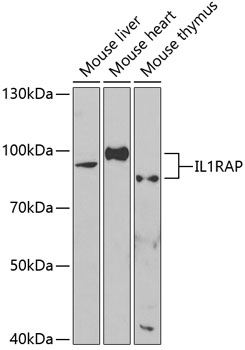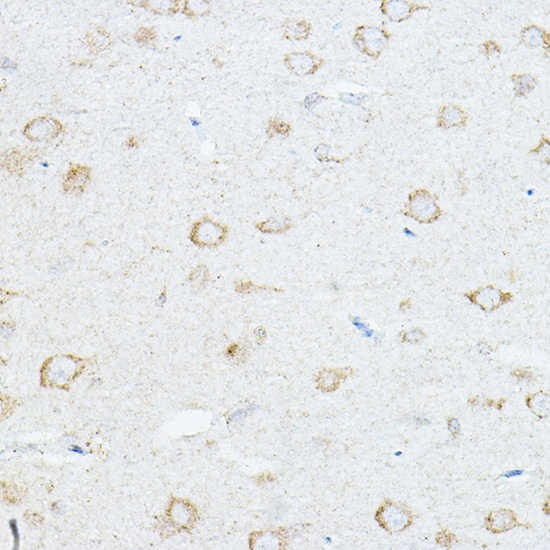Immunology Antibodies 2
Anti-IL-1RAP Antibody (CAB5349)
- SKU:
- CAB5349
- Product Type:
- Antibody
- Reactivity:
- Human
- Reactivity:
- Mouse
- Reactivity:
- Rat
- Host Species:
- Rabbit
- Isotype:
- IgG
- Antibody Type:
- Polyclonal Antibody
- Research Area:
- Immunology
Description
| Antibody Name: | IL1RAP Rabbit Polyclonal Antibody |
| Antibody SKU: | CAB5349 |
| Antibody Size: | 20uL, 50uL, 100uL |
| Application: | WB IHC |
| Reactivity: | Human, Mouse, Rat |
| Host Species: | Rabbit |
| Immunogen: | Recombinant fusion protein containing a sequence corresponding to amino acids 21-356 of human IL1RAP (NP_001161402.1). |
| Application: | WB IHC |
| Recommended Dilution: | WB 1:500 - 1:2000 IHC 1:50 - 1:200 |
| Reactivity: | Human, Mouse, Rat |
| Positive Samples: | Mouse liver, Mouse heart, Mouse thymus |
| Immunogen: | Recombinant fusion protein containing a sequence corresponding to amino acids 21-356 of human IL1RAP (NP_001161402.1). |
| Purification Method: | Affinity purification |
| Storage Buffer: | Store at -20'C. Avoid freeze / thaw cycles. Buffer: PBS with 0.02% sodium azide, 50% glycerol, pH7.3. |
| Isotype: | IgG |
| Sequence: | SERC DDWG LDTM RQIQ VFED EPAR IKCP LFEH FLKF NYST AHSA GLTL IWYW TRQD RDLE EPIN FRLP ENRI SKEK DVLW FRPT LLND TGNY TCML RNTT YCSK VAFP LEVV QKDS CFNS PMKL PVHK LYIE YGIQ RITC PNVD GYFP SSVK PTIT WYMG CYKI QNFN NVIP EGMN LSFL IALI SNNG NYTC VVTY PENG RTFH LTRT LTVK VVGS PKNA VPPV IHSP NDHV VYEK EPGE ELLI PCTV YFSF LMDS RNEV WWTI DGKK PDDI TIDV TINE SISH SRTE DETR TQIL SIKK VTSE DLKR SYVC HARS AKGE VAKA AKVK QKGN RCGQ |
| Gene ID: | 3556 |
| Uniprot: | Q9NPH3 |
| Cellular Location: | Cell membrane, Secreted, Single-pass type I membrane protein |
| Calculated MW: | 39kDa/41kDa/65kDa/78kDa |
| Observed MW: | 90kDa |
| Synonyms: | IL1RAP, C3orf13, IL-1RAcP, IL1R3 |
| Background: | Interleukin 1 induces synthesis of acute phase and proinflammatory proteins during infection, tissue damage, or stress, by forming a complex at the cell membrane with an interleukin 1 receptor and an accessory protein. This gene encodes the interleukin 1 receptor accessory protein. The protein is a necessary part of the interleukin 1 receptor complex which initiates signalling events that result in the activation of interleukin 1-responsive genes. Alternative splicing of this gene results in two transcript variants encoding two different isoforms, one membrane-bound and one soluble. The ratio of soluble to membrane-bound forms increases during acute-phase induction or stress. |
| UniProt Protein Function: | IL1RAP: Coreceptor with IL1R1. Associates with IL1R1 bound to IL1B to form the high affinity interleukin-1 receptor complex which mediates interleukin-1-dependent activation of NF-kappa-B and other pathways. Signaling involves the recruitment of adapter molecules such as TOLLIP, MYD88, and IRAK1 or IRAK2 via the respective TIR domains of the receptor/coreceptor subunits. Recruits TOLLIP to the signaling complex. Does not bind to interleukin-1 alone; binding of IL1RN to IL1R1, prevents its association with IL1R1 to form a signaling complex. The cellular response is modulated through a non-signaling association with the membrane IL1R2 decoy receptor. Secreted forms (isoforms 2 and 3) associate with secreted ligand-bound IL1R2 and increase the affinity of secreted IL1R2 for IL1B; this complex formation may be the dominant mechanism for neutralization of IL1B by secreted/soluble receptors. Belongs to the interleukin-1 receptor family. 4 isoforms of the human protein are produced by alternative splicing. |
| UniProt Protein Details: | Protein type:Receptor, misc.; Membrane protein, integral Chromosomal Location of Human Ortholog: 3q28 Cellular Component: membrane; integral to plasma membrane; extracellular region; plasma membrane Molecular Function:signal transducer activity; interleukin-1 receptor activity Biological Process: interleukin-2 biosynthetic process; cytokine and chemokine mediated signaling pathway; innate immune response; immune response; protein complex assembly; inflammatory response |
| NCBI Summary: | Interleukin 1 induces synthesis of acute phase and proinflammatory proteins during infection, tissue damage, or stress, by forming a complex at the cell membrane with an interleukin 1 receptor and an accessory protein. This gene encodes the interleukin 1 receptor accessory protein. The protein is a necessary part of the interleukin 1 receptor complex which initiates signalling events that result in the activation of interleukin 1-responsive genes. Alternative splicing of this gene results in two transcript variants encoding two different isoforms, one membrane-bound and one soluble. The ratio of soluble to membrane-bound forms increases during acute-phase induction or stress. [provided by RefSeq, Nov 2009] |
| UniProt Code: | Q9NPH3 |
| NCBI GenInfo Identifier: | 34222652 |
| NCBI Gene ID: | 3556 |
| NCBI Accession: | Q9NPH3.2 |
| UniProt Secondary Accession: | Q9NPH3,O14915, Q86WJ7, B1NLD0, D3DNW0, |
| UniProt Related Accession: | Q9NPH3 |
| Molecular Weight: | 570 |
| NCBI Full Name: | Interleukin-1 receptor accessory protein |
| NCBI Synonym Full Names: | interleukin 1 receptor accessory protein |
| NCBI Official Symbol: | IL1RAP |
| NCBI Official Synonym Symbols: | IL1R3; C3orf13; IL-1RAcP |
| NCBI Protein Information: | interleukin-1 receptor accessory protein; IL-1R3; interleukin-1 receptor 3; IL-1 receptor accessory protein; interleukin-1 receptor accessory protein beta |
| UniProt Protein Name: | Interleukin-1 receptor accessory protein |
| UniProt Synonym Protein Names: | Interleukin-1 receptor 3; IL-1R-3; IL-1R3 |
| Protein Family: | Interleukin-1 receptor accessory protein |
| UniProt Gene Name: | IL1RAP |
| UniProt Entry Name: | IL1AP_HUMAN |
View AllClose








